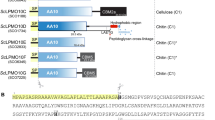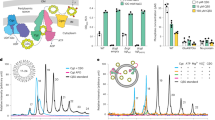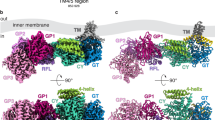Abstract
O-Acetylation of the secondary cell wall polysaccharides (SCWP) of the Bacillus cereus group of pathogens, which includes Bacillus anthracis, is essential for the proper attachment of surface-layer (S-layer) proteins to their cell walls. Using a variety of pseudosubstrates and a chemically synthesized analog of SCWP, we report here the identification of PatB1 as a SCWP O-acetyltransferase in Bacillus cereus. Additionally, we report the crystal structure of PatB1, which provides detailed insights into the mechanism of this enzyme and defines a novel subfamily of the SGNH family of esterases and lipases. We propose a model for the O-acetylation of SCWP requiring the translocation of acetyl groups from a cytoplasmic source across the plasma membrane by PatA1 and PatA2 for their transfer to SCWP by PatB1.
This is a preview of subscription content, access via your institution
Access options
Access Nature and 54 other Nature Portfolio journals
Get Nature+, our best-value online-access subscription
$29.99 / 30 days
cancel any time
Subscribe to this journal
Receive 12 print issues and online access
$259.00 per year
only $21.58 per issue
Buy this article
- Purchase on Springer Link
- Instant access to full article PDF
Prices may be subject to local taxes which are calculated during checkout





Similar content being viewed by others
Change history
04 December 2017
In the version of this article initially published online, the caption of Figure 5 incorrectly stated, "Although PatA2 resembles an acetyltransferase, its function and role remain to be determined." It should read "Although PatB2 resembles an acetyltransferase, its function and role remain to be determined." The error has been corrected in the PDF and HTML versions of this article.
References
Liu, Y. et al. Genomic insights into the taxonomic status of the Bacillus cereus group. Sci. Rep. 5, 14082 (2015).
Drobniewski, F.A. Bacillus cereus and related species. Clin. Microbiol. Rev. 6, 324–338 (1993).
Helgason, E. et al. Bacillus anthracis, Bacillus cereus, and Bacillus thuringiensis–one species on the basis of genetic evidence. Appl. Environ. Microbiol. 66, 2627–2630 (2000).
Fouet, A. & Moya, M. in Microbial Megaplasmids (ed. Schwartz, E.) 187–206 (Springer, 2008).
Koch, R. Die Ätiologie der Milzbrand-Krankheit, begründet auf die Entwicklungsgeschichte des. Bacillus anthracis. Beitr. Biol. Pflanz. 2, 277–310 (1876).
Barras, V. & Greub, G. History of biological warfare and bioterrorism. Clin. Microbiol. Infect. 20, 497–502 (2014).
Fouet, A. The surface of. Bacillus anthracis. Mol. Aspects Med. 30, 374–385 (2009).
Fagan, R.P. & Fairweather, N.F. Biogenesis and functions of bacterial S-layers. Nat. Rev. Microbiol. 12, 211–222 (2014).
Mesnage, S., Tosi-Couture, E., Mock, M., Gounon, P. & Fouet, A. Molecular characterization of the Bacillus anthracis main S-layer component: evidence that it is the major cell-associated antigen. Mol. Microbiol. 23, 1147–1155 (1997).
Etienne-Toumelin, I., Sirard, J.C., Duflot, E., Mock, M. & Fouet, A. Characterization of the Bacillus anthracis S-layer: cloning and sequencing of the structural gene. J. Bacteriol. 177, 614–620 (1995).
Mesnage, S. et al. Bacterial SLH domain proteins are non-covalently anchored to the cell surface via a conserved mechanism involving wall polysaccharide pyruvylation. EMBO J. 19, 4473–4484 (2000).
Kern, J., Ryan, C., Faull, K. & Schneewind, O. Bacillus anthracis surface-layer proteins assemble by binding to the secondary cell wall polysaccharide in a manner that requires csaB and tagO. J. Mol. Biol. 401, 757–775 (2010).
Choudhury, B. et al. The structure of the major cell wall polysaccharide of Bacillus anthracis is species-specific. J. Biol. Chem. 281, 27932–27941 (2006).
Leoff, C. et al. Structural elucidation of the nonclassical secondary cell wall polysaccharide from Bacillus cereus ATCC 10987. Comparison with the polysaccharides from Bacillus anthracis and B. cereus type strain ATCC 14579 reveals both unique and common structural features. J. Biol. Chem. 283, 29812–29821 (2008).
Forsberg, L.S. et al. Localization and structural analysis of a conserved pyruvylated epitope in Bacillus anthracis secondary cell wall polysaccharides and characterization of the galactose-deficient wall polysaccharide from a virulent B. anthracis CDC 684. Glycobiology 22, 1103–1117 (2012).
Leoff, C. et al. Cell wall carbohydrate compositions of strains from the Bacillus cereus group of species correlate with phylogenetic relatedness. J. Bacteriol. 190, 112–121 (2008).
Leoff, C. et al. Secondary cell wall polysaccharides of Bacillus anthracis are antigens that contain specific epitopes which cross-react with three pathogenic Bacillus cereus strains that caused severe disease, and other epitopes common to all the Bacillus cereus strains tested. Glycobiology 19, 665–673 (2009).
Lunderberg, J.M. et al. Bacillus anthracis acetyltransferases PatA1 and PatA2 modify the secondary cell wall polysaccharide and affect the assembly of S-layer proteins. J. Bacteriol. 195, 977–989 (2013).
Kern, J. & Schneewind, O. BslA, the S-layer adhesin of B. anthracis, is a virulence factor for anthrax pathogenesis. Mol. Microbiol. 75, 324–332 (2010).
Kern, V.J., Kern, J.W., Theriot, J.A., Schneewind, O. & Missiakas, D. Surface-layer (S-layer) proteins sap and EA1 govern the binding of the S-layer-associated protein BslO at the cell septa of Bacillus anthracis. J. Bacteriol. 194, 3833–3840 (2012).
Nguyen-Mau, S.-M., Oh, S.Y., Kern, V.J., Missiakas, D.M. & Schneewind, O. Secretion genes as determinants of Bacillus anthracis chain length. J. Bacteriol. 194, 3841–3850 (2012).
Hofmann, K.A superfamily of membrane-bound O-acyltransferases with implications for wnt signaling. Trends Biochem. Sci. 25, 111–112 (2000).
Franklin, M.J. & Ohman, D.E. Mutant analysis and cellular localization of the AlgI, AlgJ, and AlgF proteins required for O acetylation of alginate in. Pseudomonas aeruginosa.J. Bacteriol. 184, 3000–3007 (2002).
Clarke, A.J., Strating, H. & Blackburn, N.T. in Glycomicrobiology (ed. Doyle, R.J.) 187–223 (Plenum Publishing Co. Ltd., 2000).
Weadge, J.T., Pfeffer, J.M. & Clarke, A.J. Identification of a new family of enzymes with potential O-acetylpeptidoglycan esterase activity in both Gram-positive and Gram-negative bacteria. BMC Microbiol. 5, 49 (2005).
Laaberki, M.-H., Pfeffer, J., Clarke, A.J. & Dworkin, J. O-Acetylation of peptidoglycan is required for proper cell separation and S-layer anchoring in. Bacillus anthracis. J. Biol. Chem. 286, 5278–5288 (2011).
Baker, P. et al. P. aeruginosa SGNH hydrolase-like proteins AlgJ and AlgX have similar topology but separate and distinct roles in alginate acetylation. PLoSPathog 10, e1004334 (2014).
Weadge, J.T. et al. Expression, purification, crystallization and preliminary X-ray analysis of Pseudomonas aeruginosa AlgX. Acta Crystallogr. Sect. F Struct. Biol. Cryst. Commun. 66, 588–591 (2010).
Riley, L.M. et al. Structural and functional characterization of Pseudomonas aeruginosa AlgX: role of AlgX in alginate acetylation. J. Biol. Chem. 288, 22299–22314 (2013).
Akoh, C.C., Lee, G.C., Liaw, Y.C., Huang, T.H. & Shaw, J.F. GDSL family of serine esterases/lipases. Prog. Lipid Res. 43, 534–552 (2004).
Moynihan, P.J. & Clarke, A.J. Assay for peptidoglycan O-acetyltransferase: a potential new antibacterial target. Anal. Biochem. 439, 73–79 (2013).
Moynihan, P.J. & Clarke, A.J. Substrate specificity and kinetic characterization of peptidoglycan O-acetyltransferase B from. Neisseria gonorrhoeae. J. Biol. Chem. 289, 16748–16760 (2014).
Weadge, J.T. & Clarke, A.J. Identification and characterization of O-acetylpeptidoglycan esterase: a novel enzyme discovered in. Neisseria gonorrhoeae. Biochemistry 45, 839–851 (2006).
Moynihan, P.J. & Clarke, A.J. Mechanism of action of peptidoglycan O-acetyltransferase B involves a Ser-His-Asp catalytic triad. Biochemistry 53, 6243–6251 (2014).
Goldschmidt, L., Cooper, D.R., Derewenda, Z.S. & Eisenberg, D. Toward rational protein crystallization: a web server for the design of crystallizable protein variants. Protein Sci. 16, 1569–1576 (2007).
Almog, O. et al. The 0.93A crystal structure of sphericase: a calcium-loaded serine protease from. Bacillus sphaericus. J. Mol. Biol. 332, 1071–1082 (2003).
Heikinheimo, P., Goldman, A., Jeffries, C. & Ollis, D.L. Of barn owls and bankers: a lush variety of α/β hydrolases. Structure 7, R141–R146 (1999).
Oh, S.Y., Lunderberg, J.M., Chateau, A., Schneewind, O. & Missiakas, D. Genes required for Bacillus anthracis secondary cell wall polysaccharide synthesis. J. Bacteriol. 199, e00613–e00616 (2016).
Moynihan, P.J. & Clarke, A.J. O-acetylation of peptidoglycan in gram-negative bacteria: identification and characterization of peptidoglycan O-acetyltransferase in. Neisseria gonorrhoeae. J. Biol. Chem. 285, 13264–13273 (2010).
Larsen, N.A., Lin, H., Wei, R., Fischbach, M.A. & Walsh, C.T. Structural characterization of enterobactin hydrolase IroE. Biochemistry 45, 10184–10190 (2006).
Franklin, M.J., Douthit, S.A. & McClure, M.A. Evidence that the algI/algJ gene cassette, required for O-acetylation of Pseudomonas aeruginosa alginate, evolved by lateral gene transfer. J. Bacteriol. 186, 4759–4773 (2004).
Little, D.J. et al. Combining in situ proteolysis and mass spectrometry to crystallize Escherichia coli PgaB. Acta Crystallogr. Sect. F Struct. Biol. Cryst. Commun. 68, 842–845 (2012).
Mo, K.F. et al. Endolysins of Bacillus anthracis bacteriophages recognize unique carbohydrate epitopes of vegetative cell wall polysaccharides with high affinity and selectivity. J. Am. Chem. Soc. 134, 15556–15562 (2012).
Otwinowski, Z. & Minor, W. Processing of X-ray diffraction data collected in oscillation mode. Methods Enzymol. 276, 307–326 (1997).
Pape, T. & Schneider, T.R. HKL2MAP: a graphical user interface for phasing with SHELX programs. J. Appl. Crystallogr. 37, 843–844 (2004).
Terwilliger, T.C. Automated main-chain model building by template matching and iterative fragment extension. ActaCrystallogr. D Biol. Crystallogr. 59, 38–44 (2003).
Terwilliger, T.C. et al. Iterative model building, structure refinement and density modification with the PHENIX AutoBuild wizard. ActaCrystallogr. D Biol. Crystallogr. 64, 61–69 (2008).
Emsley, P. & Cowtan, K. Coot: model-building tools for molecular graphics. ActaCrystallogr. D Biol. Crystallogr. 60, 2126–2132 (2004).
Afonine, P.V. et al. Towards automated crystallographic structure refinement with phenix.refine. ActaCrystallogr. D Biol. Crystallogr. 68, 352–367 (2012).
Painter, J. & Merritt, E.A. TLSMD web server for the generation of multi-group TLS models. J. Appl. Crystallogr. 39, 109–111 (2006).
Chen, V.B. et al. MolProbity: all-atom structure validation for macromolecular crystallography. ActaCrystallogr. D Biol. Crystallogr. 66, 12–21 (2010).
Gasteiger, E. et al. in The Proteomics Protocols Handbook (ed. Walker, J.M.) 571–607 (Humana Press, 2005).
Chenna, R. et al. Multiple sequence alignment with the Clustal series of programs. Nucleic Acids Res. 31, 3497–3500 (2003).
Yu, N.Y. et al. PSORTb 3.0: improved protein subcellular localization prediction with refined localization subcategories and predictive capabilities for all prokaryotes. Bioinformatics 26, 1608–1615 (2010).
Käll, L., Krogh, A. & Sonnhammer, E.L.L.A combined transmembrane topology and signal peptide prediction method. J. Mol. Biol. 338, 1027–1036 (2004).
Petersen, T.N., Brunak, S., von Heijne, G. & Nielsen, H. SignalP 4.0: discriminating signal peptides from transmembrane regions. Nat. Methods 8, 785–786 (2011).
Krogh, A., Larsson, B., von Heijne, G. & Sonnhammer, E.L.L. Predicting transmembrane protein topology with a hidden Markov model: application to complete genomes. J. Mol. Biol. 305, 567–580 (2001).
Claros, M.G. & von Heijne, G. TopPred II: an improved software for membrane protein structure predictions. Comput. Appl. Biosci. 10, 685–686 (1994).
Remmert, M., Biegert, A., Hauser, A. & Söding, J. HHblits: lightning-fast iterative protein sequence searching by HMM-HMM alignment. Nat. Methods 9, 173–175 (2011).
Laemmli, U.K. Cleavage of structural proteins during the assembly of the head of bacteriophage T4. Nature 227, 680–685 (1970).
Acknowledgements
We thank D. Brewer and A. Charchoglyan of the Mass Spectrometry Facility (Advanced Analysis Centre, University of Guelph) for expert technical assistance and advice, both R. Pfoh and N.C. Bamford of the Howell laboratory for their assistance in X-ray data collection, and C. Jones for technical assistance with some of the enzyme assays. P.J. Moynihan, J.M. Pfeffer, J.C. Whitney and J.T. Weadge are thanked for helpful discussions in the early stages of this research. These studies were supported in part by operating grants from the Canadian Institutes of Health Research (CIHR) to A.J.C. (TGC 114045) and P.L.H. (MOP 43998) and the Canadian Glycomics Network (http://dx.doi.org/10.13039/501100009056). J.L. was supported in part by graduate scholarships from the University of Toronto, the Ontario Graduate Scholarship Program, and CIHR. P.L.H. is the recipient of a Canada Research Chair. The National Synchrotron Light Source beam line X29A is supported by the United States Department of Energy Office of Biological and Environmental Research and the National Institutes of Health National Centre for Research Resources.
Author information
Authors and Affiliations
Contributions
D.S. conceived all experiments and performed all gene cloning, site-directed mutagenesis and expression experiments; purification of recombinant proteins; enzyme kinetic and MS analyses; crystallization of proteins; collection and analysis of crystallographic data; and solving of crystal structures; and made structural figures and tables; D.J.L. and P.L.H. oversaw the collection and analysis of crystallographic data; R.N.C. and G.-J.B. synthesized the SCWP model compound, MGG, and performed all NMR experiments; H.R. collected crystallographic data; A.J.C. helped conceive the cloning, protein purification, kinetic and MS experiments, analyzed data and oversaw the work of D.S. D.S. and A.J.C. wrote the paper with contributions from all authors.
Corresponding author
Ethics declarations
Competing interests
The authors declare no competing financial interests.
Supplementary information
Supplementary Text and Figures
Supplementary Results, Supplementary Tables 1–4 and Supplementary Figures 1–18 (PDF 9039 kb)
Supplementary Note 1
Synthesis of MGG (PDF 602 kb)
Rights and permissions
About this article
Cite this article
Sychantha, D., Little, D., Chapman, R. et al. PatB1 is an O-acetyltransferase that decorates secondary cell wall polysaccharides. Nat Chem Biol 14, 79–85 (2018). https://doi.org/10.1038/nchembio.2509
Received:
Accepted:
Published:
Issue Date:
DOI: https://doi.org/10.1038/nchembio.2509
This article is cited by
-
Mechanism of d-alanine transfer to teichoic acids shows how bacteria acylate cell envelope polymers
Nature Microbiology (2023)
-
A rapid and efficient technique for the isolation of Bacillus genomic DNA using a cocktail of peptidoglycan hydrolases of different type
World Journal of Microbiology and Biotechnology (2023)
-
Identification of critical residues of O-antigen-modifying O-acetyltransferase B (OacB) of Shigella flexneri
BMC Molecular and Cell Biology (2022)
-
Bacterial biopolymers: from pathogenesis to advanced materials
Nature Reviews Microbiology (2020)
-
Structural and mechanistic basis of capsule O-acetylation in Neisseria meningitidis serogroup A
Nature Communications (2020)



